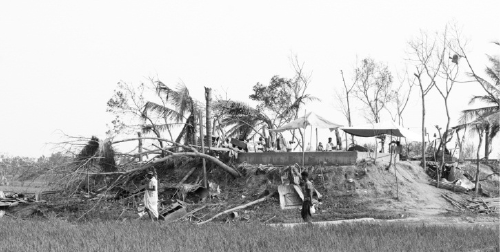Tornadoes in Bangladesh and East India
Findings: Comprehensive study to find tornado reports from 1838 to 2001 over 85 tornadoes identified. 75% of the tornadoes occur in the central and southern portions of Bangladesh (about 8,000 sq mi). The majority of violent tornadoes are concentrated around an area smaller than Los Angeles County. Harrowing reports of destruction including trees and people being carried over a mile and that tornadoes were most common in mid to late April with south-southeast or southeast storm motions.
On his site bangladeshtornadoes.org Jon has established a large number of case studies and professional observations on the severe storm climatology of Bangladesh. For several years he operated a defacto SPC for Bangladesh, issuing convective outlooks and tornado watches and amassing a large database of meteorological data and the trends that come with it. His findings show:
1) Almost all tornadoes occur on the nose of a 250mb jet as it dives in associated with a wave.
2) A dry airmass in India mixes east and puts the dryline somewhere between Kolkata and Sajinipara though it can occasionally mix farther east or west depending on the upper features driving it.
3) A trough/warm-front is usually present east-west from Dhaka or Mymensingh.
4) An outflow boundary is extremely common due to convection forming in the Khasi Hills and modifying the airmass across all of Northeast Bangladesh. Many storms and tornaodes are associated with this outflow boundary. The intersection of this trough and outflow boundary may of be of particular interest.
Meteorological Characteristics of Tornadoes in Bangladesh
Another paper from the authors of the Severe local convective storms in Bangladesh: Part I. Climatology, this one examines meteorological indices. They used the HSS to determine to test a series of parameters for their threshold and ability to detect (or false alarm) an event. It showed that LI and PW were the most effective available. The threshold for severe weather was -2.6C Lifted Index and 1121 J/KG CAPE. Further analyzes a tornado that occurred on May 13, 1966 that killed 525 people, injured 32,601 and killed or injured 420,000 animals (yikes). Given a F3 rating based on damage to a school building made of concrete with beams and reinforced for high winds. The report once again reinforces that many deaths were attributable to the use of large amounts of tin in structures.
Findings: Claims Bangladesh experiences six tornadoes a year (winds over 100mph). Focuses on a tornado that destroyed 38 villages and was 1/2 mile wide and on the ground for an hour – killing 111. Cited findings from Ono state that 60% of all tornadoes resulted in fatalities, while that figure is 3.2% in the United States.
Findings: Research paper on a tornado that occured at 5:10PM on March 22nd, 2013. It was on the ground for 15 minutes and traveled 12km with a relatively small but focused damage path of 60-80m. 35 deaths, thousands of trees uprooted and destruction of a highly forfeited prison wall.

Most houses were tin or built of trees but even the brick structures were destroyed (though likely not as well built).
Tornadoes in the districts of Jamalpur and Tangail in Bangladesh
Findings: Report from 1981 analyzing satellite imagery found that 76% of severe thunderstorms occurred before the monsoon season. Analyzes a tornado family that wreaked havoc for two hours with a maximum path width of 1.2km and given a field rating of F4. Reports of soft-ball sized hail and generally mentioned meteorological conditions of very dry air from India, cool air aloft from Nepal/Tibet and extremely moist and warm air over Bangladesh. This report cites that during the studied period of 1990-1994 8.8 tornadoes were reported per year, with the majority during APR/MAY. Common village houses are tin, straw/tin hybrid or bamboo.
Tornado in Brahmanbaria 2013 Risk Factors for Injury and Death from a Tornado in Rural Bangladesh
Findings: This report cites 55 deaths instead of 35, there is also a theme mentioned previous article about almost all injuries being the result of lacerations and cuts from flying debris (likely in many cases tin).
Severe local convective storms in Bangladesh: Part I. Climatology
In Bangladesh any storm over 81kts is considered a tornado – though there is not a great amount of metar stations able to record this amount or damage surveys. Anything from 21 to 80kts falls under the term Nor’Wester. This study is based off an examination of 2,324 severe convective storms beetween 1990- 2005. As for time of day, there are two peaks with one in late afternoon (4-5PM) and one in the later evening (7-11Pm). Like the work of Jon Finch that showed highest tornado frequency in April, this large database also shows a storm peak in April. It’s wondered whether the extreme population density and infrastructure in Dhaka has resulted in a bias showing that as the most common region.
Severe local convective storms in Bangladesh: Part II.
Risk Factors for Injury and Death from a Tornado in Rural Bangladesh
Focuses on a March 20, 2005 tornado that killed 56 and injured 3,710 people. Identifies most injuries as the result of cuts from debris (again likely lots of tin which gets torn into small pieces and is quite aerodynamic.) Those found indoors were more likely to be protected. Bamboo houses were more likely to get destroyed while tin houses were more likely to result in injury. 20% of the deaths resulted from post traumatic infection.
Characteristics of Damages of Severe Local Storms Based on Field Surveys In Bangladesh
Describes a series of interviews with tornado victims of fairly typical tornadic encounters, including seeing a funnel cloud, the sky growing dark, lightning and hail afterwards. Also describes pressure changes associated with ringing or popping of the ears. Seems to certainly verify the mesocyclonic nature of such tornadoes.

